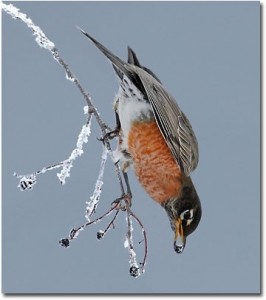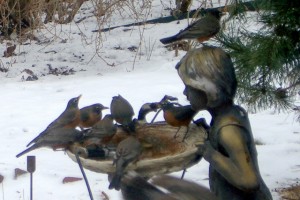Backyard Bird Count
The Great Backyard Bird Count begins TODAY. Last year, 603 varieties were recorded on more than 97,000 check lists, for a total of 11, 233,000 birds. One million eight hundred thousand American Robins were counted this year, more than any other bird.
The robin was also the top winner in the photo contest. This picture was taken by Nick Saunders of Saskatchewan.
Though robins are known as migratory, they often stay close to their place of birth. They winter over sharing with cardinals the berries of viburnum, dogwood, pyracantha and cedar to name a few.
Right after the infamous blizzard, we had as many as eight thirsty robins fighting for water at the birdbath. Glenn trekked out often to replenish their supply. A friend of ours called to report twenty five robins in her front yard. I wondered if maybe she didn’t have a water leak.
We enjoy feeding the birds. The oily sunflower seed is the favorite but the finches like thistle seed as well. Once, awhile back, a feral cat began to stalk our birds. He was a BIG cat, black and gray, with a long tail. I’d see him sitting all bunched up watching the tiny chickadees flit in and out but he waited silently under the pine tree for the doves to come. He especially favored the plump ones nibbling on the seeds dropped on the ground by the titmouse and sparrows. I never actually saw the cat catch one of the birds but I often saw the leftovers.
The cat had no collar. I inquired around but no one claimed him. He wouldn’t let me near him so we borrowed a trap from the animal control people, baited it with tuna, caught him and took him to a great, big park with plenty of cover and water and whatever else cats might need. We wished him well and the birds in our yard have done much better.
It’s important to count birds. Migration is key to the existence of some breeds. Those that migrate long distances need to be in the right place to feed and nest at just exactly the right time. Globe warming is disrupting some of these migration and reproductive patterns. We counters can help scientists evaluate what’s happening. In addition, we help ornithologists study numbers and variety of birds and their food supply. Compared over a period of years, the statistics we forward to the Cornell scientists are meaningful predictors of the future.
This is The Great Backyard Bird Count website where you will find—
It’s as easy as 1, 2, 3!
1. Plan to count birds for at least 15 minutes on one or more days of the count. You can count for longer than that if you wish! Count birds in as many places and on as many days as you like—one day, two days, or all four days. Submit a separate checklist for each new day. You can also submit more than one checklist per day if you count in other locations on that day.
2. Count the greatest number of individuals of each species that you see together at any one time. You may find it helpful to print out your regional bird checklist to get an idea of the kinds of birds you’re likely to see in your area in February. You could take note of the highest number of each species you see on this checklist.
3. When you’re finished, enter your results through our web page. You’ll see a button marked “Enter Your Checklists!” on the website home page beginning on the first day of the count. It will remain active until the deadline for data submission on March 1st.




Leave a Reply